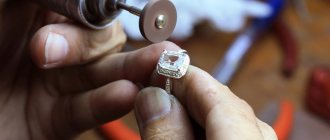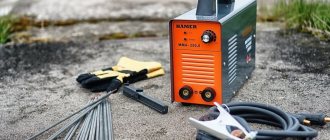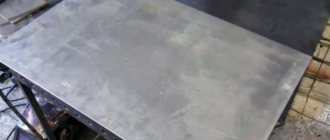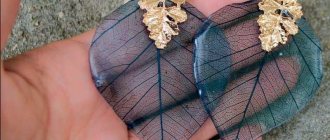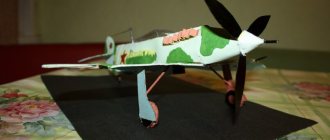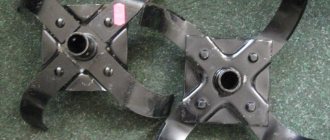Profile pipes are metal products used for the construction of greenhouses, greenhouses, gazebos, and canopies. Often, square or rectangular tubular products must be bent to a specific radius to achieve the desired result. The pipe is bent by applying pressure force: either at room temperature or at elevated temperature. The technology for bending a profile along a radius is selected taking into account the cross-sectional dimensions, wall thickness, and the material from which it is made. In home workshops, they usually bend profile products from steel (with a small cross-section) and softer non-ferrous metals and their alloys.
Selecting a bend method
How to bend a pipe with your own hands? The question is not an easy one. When bending this product yourself, first of all, it is important to take into account the fact that during this process radial and tangential forces arise in the profiled metal, the impact of which can lead to rupture of the section and the appearance of folds on it.
To prevent this from happening, when forming a bend, it is necessary to take into account all the parameters of this process.
The technology that can be applied in each specific case is selected based on:
- Pipe material;
- Its size;
- Required bend angle and radius.
Having made a preliminary assessment of these parameters, you should choose one of the options proposed below. The photos below will help you understand the correct implementation of each of them, demonstrating step by step how to bend a pipe.
Wall greenhouse
During the years of widespread replacement of wooden window frames with plastic windows, many made wall-mounted greenhouses, which were installed on the south side of the house or outbuilding. Now you will have to make the frames for the greenhouse yourself, but it is not difficult. Both polycarbonate and film can be used in the design. In central Russia, such a greenhouse with glass frames could already grow greens, cabbage and other cold-resistant crops from April.
To build such a greenhouse, you will need:
- greenhouse frames;
- bars with a thickness of 10 cm for wooden strapping;
- croaker;
- tarpaulin.
A harness is made from the bars, to which the frames are attached with pieces of tarpaulin. This will make it easy to raise the desired frame for access to plants or ventilation. From below, stops are made for the frames, sewing the rail to the bottom bar.
The side walls should be sewn up with a slab, and their lower part should be covered with earth.
Heat
When exposed to high temperatures, many metals and their alloys become more ductile and less deformable. This rule applies to aluminum, duralumin, steel, copper, brass products and aluminum-ferrous bronze workpieces.
- When heating pipes made of tin bronze, gray cast iron or zinc alloys, you can get the exact opposite effect - they become more brittle when heated.
- It follows from this that not just any pipe can be heated for bending.
- It is possible to heat galvanized pipes, since their coating is not damaged in this case.
- When heating the product, you should not get too carried away, because under the influence of too high temperatures, oxygen begins to penetrate into the material, which entails its oxidation - an irreversible process that destroys the pipe. As an example, we can consider bending an aluminum billet.
- We heat the bending surface and bring a sheet of paper to it. If it lights up, the product can be bent.
As an indicator of the degree of heating of structures made of steel, their reddening to the state of scale can be used.
How to make wooden arcs for a greenhouse with your own hands
Summer residents often use wooden beams for outbuildings, so there are always leftover materials on the site. A wooden greenhouse frame is easy to make. For work you will need boards, timber, nails or screws, a screwdriver or a hammer. Wood is an eco-friendly, durable material and is therefore well suited for constructing a greenhouse. The only drawback is rotting. Therefore, during the work, the frame is covered with moisture-proofing and fire-resistant agents. Sequence of work:
- Dimensions are measured in the prepared area. The base is made from 10*10 cm timber. According to the length, prepare 3-5 pieces of 5*5 cm timber. Determine the length of the arc. Divide the resulting value into six equal segments. Prepare parts from boards 2-3*7-10 cm.
- Vertical sections are attached to the base every 50 cm. The top is fastened with a horizontal support. The following sections of boards are attached vertically to the second beam. Repeat the fastening of the beam and end the frame with a central supporting part.
- If desired, the boards are given a rounded shape. The finished frame is covered with film or polycarbonate. The wooden frame is treated with an antiseptic and insect repellent
Filling with water or sand
Water is poured into the cavity of the workpiece, after which plugs are installed at both ends and cold is placed so that it freezes.
The product is bent by subsequently heating it with a gas burner. This method is not suitable for pipes that have a galvanized coating, as it can lead to damage.
The method using sand is applicable to pipes with a large cross-section or square configuration. Its essence lies in the preliminary filling of the workpiece cavity with sand. Then the pipe is thoroughly heated and bent by tapping it with a mallet. No heat is required to bend galvanized structures.
How to make fiberglass arcs for a greenhouse with your own hands
Greenhouses are made quickly and easily from fiberglass reinforcement. The material is durable and bends well. Well suited for arranging temporary spring greenhouses for growing seedlings.
To make arcs for the greenhouse, prepare fiberglass rods and plastic clamps for fastening. Stages of making a greenhouse:
- Fiberglass reinforcement is lightweight and easy to use. The site is being prepared for the construction of a greenhouse. They clear away debris, apply fertilizer and dig up. Using a flat cutter or hoe, mark the size of the greenhouse on the ground. Measure the length of the arc and greenhouse. The arcs are made 50 cm longer than the obtained value.
- According to the identified dimensions, fiberglass pieces are prepared. The length of the greenhouse is divided by 50 cm and 1 piece is added. on the end, get the number of arcs. For fixing, it is necessary to prepare horizontal fastening beams. Their number depends on the height of the greenhouse. If the height is 2 m, then nine pieces will be required; if the height is 1 m, then seven horizontal beams are prepared.
- The sections for the arcs are stuck into the ground 20-30 cm every 50 cm. The horizontal fastening sections are secured using plastic clamps. The greenhouse is covered with film or agrofibre.
In order not to make holes in the covering material, it is fixed with twine, which is attached to the lower horizontal section
Using Templates
This method is suitable for making complex pipe bends. The simplest template can be a piece of wire, pre-bent in accordance with how the product will be bent.
If it is possible to place the bent pipe section on a plane, self-tapping screws twisted into a piece of plywood can act as a kind of template. Bending is done gradually, checking the resulting result with the template from time to time.
How to make arcs from old hoses for a greenhouse with your own hands
An old watering hose bends well. This material is perfect for a seasonal greenhouse. Work order:
- The area is being leveled. Mark the perimeter of the greenhouse. To keep the hose in place, it is placed on a metal or wooden stake. The reinforcement or a piece of branch is driven into the ground after 50 cm.
- The ends of the hose are put on the installed pegs, giving the shape of an arc.
- To fix the position, the structure is fixed with transverse bars made of a hose or branches.
- The frame is covered with covering material.
For temporary structures, arches are made from a metal rod with a cross-section of 10 mm
Application of rolls
This method is suitable for bending a metal profile. It is good because its use reduces friction on the surface of the product and reduces the risk of unwanted deformation.
As a result, much less effort has to be applied to obtain the desired bend, and damage to the part is minimized.
Using rolls, you can make your own pipe bender for bending pipes, allowing you to avoid the use of long parts. The three-roller version is most often used. Two rollers located in it play the role of outer supports, and the third one presses into the center of the fold.
This homemade device allows you to process round pipes, rectangular profiles, as well as plates and corners. Using it, you can bend the same radius over a fairly large length of the workpiece.
Industrial cold bending methods
Depending on the diameter of the element and the volume of work, hand tools (pipe benders) or devices with an electromechanical drive can be used.
Basic industrial cold bending methods:
- Winding method. This technique allows you to bend a pipe with a cross-section in the range of 1.0-4.26 cm in different planes. To maintain the shape of the section, composite or rod mandrels are used - calibrating plugs.
- With a run-in. This method is suitable for bending tubular elements with a diameter of no more than 15 cm. In this case, the wall thickness should be impressive. The essence of the method: a rolling roller moves around a static bending roller of a given size. He presses the pipe and bends it.
- Rolling. This method allows you to bend the workpiece in a spiral or into a ring. On rollers, the element is moved by rollers and acquires the curvature specified by the position of the rollers.
- By dragging. The method is suitable for bending thin-walled, seamless products. For bending, a template is made from a tubular element of larger diameter. The template is then threaded through the die and secured with a clamp. Due to the rotation of the template, the workpiece is pulled through the die and bent.
- By stretching. This technique allows you to minimize the risk of metal deformation. To do this, the workpiece is fixed at the edges, stretched and bent simultaneously through the use of a bending template.
- On supports. Typically, two supports are used on which the workpiece is laid. As the supports bend, they rotate around their axis. The template is connected to the jack rod so that the force is applied in the center of the workpiece. The method is suitable for bending tubular products with a diameter of no more than 35.1 cm. The equipment allows bending to be performed directly on the construction site.
- With hydrostatic pressure inside. To do this, liquid is injected into the tubular element. Plugs are installed at the ends. Due to the stresses that arise, the metal reaches an almost plastic state. Then a template is brought to the bending point and the workpiece is bent.
- With pushing. The method is suitable for bending elements with a diameter within three inches. The workpiece is pushed through a fixed and movable die. Due to the displacement of the matrices relative to each other, the curvature of the bend can be adjusted. Using this technique, one workpiece can be bent several times in different planes.
As for the use of mandrels, the simplest plug for pipes with a cross-section of no more than 3.2 cm can be a steel cable. One end of this cable is fixed in the handle. The other end is connected to the wire to pull into the lumen. In this case, the diameter of the calibrating plug should be slightly smaller than the cross-section of the tubular product - approximately 0.1-0.5 mm.
When using calibration plugs, unwanted scratches and nicks may occur on the inner surface of the workpiece. This usually happens when bending stainless steel products. To protect against such undesirable consequences, you need to choose the right material for making the cork, as well as use lubricant and thoroughly clean the surface.
Spring
The essence of this option is to place a spring of the required diameter, made of steel, into a bendable workpiece.
When bending, it holds the pipe, preventing it from being deformed incorrectly. The pre-profile element with a spring inserted into it is heated and then bent using pliers.
In certain cases, the spring can be replaced with a wire. Its bundle is installed in the pipe in separate pieces, and after the bend is completed, it is gradually pulled out.
Profile pipes
Profile pipes can have square, oval and rectangular configurations. It is quite difficult to bend them without violating the technical specifications. The most successful option for carrying out the work would be to use welding with preliminary filing of the walls of the workpiece with a grinder where the bend is planned.
Moreover, it would be advisable to first make cuts and bend the workpiece, and then weld the seams. If the part has a small diameter, then a regular soldering iron will do instead of welding.
How to make arches from willow twigs for a greenhouse with your own hands
Willow twigs have long been famous for their flexibility. They are used to weave baskets and openwork fences. The only drawback is the fragility of the material, it will last for a maximum of 1-2 seasons.
Important! The production of arcs for a greenhouse from willow twigs begins with soaking the material in water a day before use. This procedure will make it easy to bend the branches.
Instructions for performing the work:
- The area for the greenhouse is leveled and marked using a scoop or rake. Prepare the material. Select long willow twigs and cut the required amount. To ensure that the arc stands firmly, several rods are tied together. Therefore, having decided on the length of the greenhouse, calculate the amount of material based on a step of 50 cm between the arc.
- 50 cm long stakes are prepared from thick branches of maple or hazel. They are stuck into the ground according to markings every 50 cm.
- The prepared willow twigs are tied to a peg with twine or a plastic clamp. If the arc consists of several branches, they are tied into a bundle.
- To add rigidity to the structure, willow rods are attached transversely.
- The frame is covered with agrofibre or polyethylene film.
On both sides, the covering material is pressed from below with bricks or boards
Metal-plastic pipes
They bend well by hand without requiring heating. The main thing is to ensure that the workpiece does not become excessively bent.
To perform the bend, you can also use wire by inserting it into the cavity of the metal-plastic pipe being bent, or connect heating to this procedure, while controlling the resulting temperature with a paper sheet.
What defects can occur if the technology is incorrectly chosen or violated?
The process is accompanied by tensile forces that act on the outer part of the bend, and compressive forces on the inner part. It is possible to produce a high-quality product only if you know the technological rules of the process, otherwise the following are likely:
- violation of the alignment of areas;
- the appearance of cracks on the wall located on the outside of the bend;
- formation of uneven folds on the inside of the bend;
- divergence of the seam of the welded profile.
Advice!
To avoid defects, it is recommended to bend pipes with a profile height (h) of up to 20 mm on a segment whose length is equal to or greater than 2.5*h. If the profile height is more than 20 mm, then the minimum segment is 3.5*h. Thin-walled products with a large cross-section (wall thickness less than 2 mm) cannot be bent to obtain a high-quality part.
Plastic low-carbon unalloyed and low-alloy steel grades are characterized by some “springiness”. This means that after bending the pipe tends to restore its previous position. Therefore, for such products, fitting to a template is often necessary.
